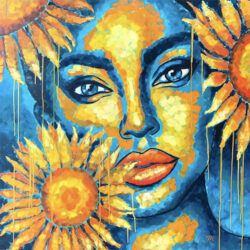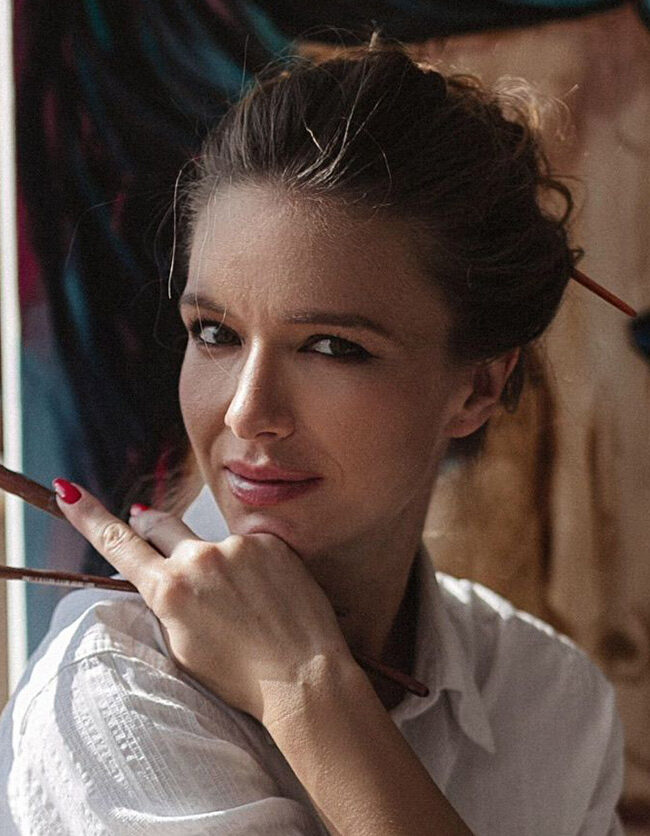
Using art to survive the war: the story of Anna Briukhovetska

Using art to survive the war: the story of Anna Briukhovetska
The artist continued to paint even after the start of the war on 24 February, drawing the feelings of a people in the clutches of despair and the pain of the conflict. DVArea chose to support her art in this destruction phase. Art builds, elevates, builds bridges, erects futures and hopes.
“It is very difficult to describe our life today, everything has changed. There is a lot of pain”. Ukrainian artist Anna Briukhovetska, was born in Donetsk, and resides in Odessa. War wounds the soul, but Anna, despite everything, has always continued to use painting as therapy.
Supporting art means choosing to take a stand in this phase of destruction. Art builds, elevates, builds bridges, erects futures and hopes. In this vein, DVArea, as a benefit company, aware that culture is a product characterised by both private enjoyment and social value, decided to support Briukhovetska’s creativity.

Anna’s painting on display in our studio
While communities were being destroyed, Anna continued with her paints and brushes. The history of war has always been almost unceasingly intertwined with the history of cities, as seen, amongst many other cases, by the very distant events of Carthage (during the Third Punic War) or Stalingrad (World War II).
Anna, to start with, where were you when the war broke out?
On 24 February, we were woken up by explosions. There was crying, shouting. We were shocked. What we felt was fear and pain. Feelings we had felt for some time, several years before in the Donetsk region.
What did you do in the following days?
The first thing I did was to enrol as a volunteer in the territorial defence of Odessa. Ten days later with the start of hostilities throughout Ukraine, I decided to escape to safety in Romania with my daughter. I painted non-stop making a series of paintings that reflected my feelings from the beginning of the war: despair, the pain of separation, fear, faith, the bitterness of loss, anger, love and freedom. Some of these works are already in private collections in Germany, the United States and Canada. Part of my profits are always donated to the volunteer fund to help the Ukrainian military. I have now returned to Ukraine, to my home in Odessa. There is still no security, my family and I have decided to face these difficult times together. I am working on a new series of paintings that will be called “Life amidst air raid sirens”.
Inclusive, resilient and sustainable cities. These are the categories used for cities at peace. Today it is difficult for you to talk about Donetsk and Odessa, but can you tell us what they were like before the war?
It is very difficult to talk about my life before the war. I have difficulty putting it into focus. Donetsk was the largest industrial and commercial centre in Ukraine with a modern infrastructure, vitality and culture: European-standard hotels and restaurants, cinemas and theatres, the Donbass Arena stadium, which even hosted matches in the 2012 European Championships, and the Donetsk Ballet School, also recognised abroad – all this was part of the city’s extraordinariness. Today, the region is depressed and has been deprived of all its wealth and productive activity. Factories were looted and most of the mines were flooded. Our family business had to stop, our property was nationalised by the new government of this now unrecognisable republic. Before the war, Odessa was the largest tourist, cultural and historical centre in Ukraine. Tourism, festivals, international exhibitions, and beautiful beaches are now abandoned for fear of mines.
There has been talk of the urbanisation of conflict; today war is increasingly being fought inside cities. With what consequences?
The consequences are devastating in terms of civilian casualties and destruction of non-military buildings and infrastructure. We are all in danger every day and every night.
Is there a risk today that Ukrainian cities will become the occasion for a new definition of the concept of urbicide? In other words, will the conflict, in your opinion, result in cities being reduced to rubble as a way of erasing their Ukrainian identity?
Yes, of course, that is the risk. Russia’s war against Ukraine is genocide. They destroy schools, universities, theatres and museums with this very aim. The occupied territories are experiencing human rights violations. Let’s be clear about this: we are not fighting just for our land and our freedom. We are fighting to keep our culture alive and art is a fundamental tool.
Art and war, Goya, with the disasters of war, and Picasso with Guernica had already given voice to the most atrocious pain. How has the conflict influenced your artistic language?
Of course military developments have a great influence on me because my art always reflects my feelings. Today I use stronger, brighter colours with more contrasts. I can’t say my style has changed: my portraits of women are still my most important subject, however the women on my canvases reflect my state of mind and the state of mind of every Ukrainian woman. And their eyes are often filled with tears, but they still have a ray of hope.
Interview collected by Francesca Fradelloni, PPAN

To learn more about Anna Briukhovetska
Discover her works and support her art too.



